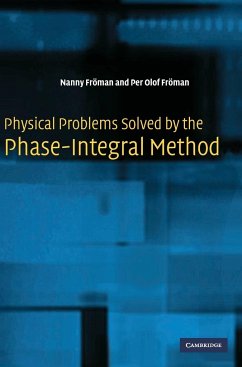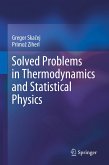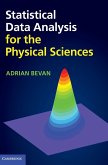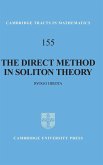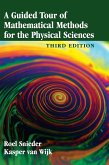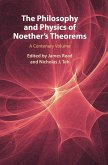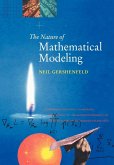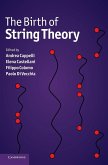- Gebundenes Buch
- Merkliste
- Auf die Merkliste
- Bewerten Bewerten
- Teilen
- Produkt teilen
- Produkterinnerung
- Produkterinnerung
A mathematical approximation method important for many branches of theoretical physics, applied mathematics and engineering.
Andere Kunden interessierten sich auch für
![Solved Problems in Thermodynamics and Statistical Physics Solved Problems in Thermodynamics and Statistical Physics]() Gregor SkacejSolved Problems in Thermodynamics and Statistical Physics60,99 €
Gregor SkacejSolved Problems in Thermodynamics and Statistical Physics60,99 €![Statistical Data Analysis for the Physical Sciences Statistical Data Analysis for the Physical Sciences]() Adrian BevanStatistical Data Analysis for the Physical Sciences71,99 €
Adrian BevanStatistical Data Analysis for the Physical Sciences71,99 €![The Direct Method in Soliton Theory The Direct Method in Soliton Theory]() Ryogo HirotaThe Direct Method in Soliton Theory133,99 €
Ryogo HirotaThe Direct Method in Soliton Theory133,99 €![A Guided Tour of Mathematical Methods for the Physical Sciences A Guided Tour of Mathematical Methods for the Physical Sciences]() Roel SniederA Guided Tour of Mathematical Methods for the Physical Sciences121,99 €
Roel SniederA Guided Tour of Mathematical Methods for the Physical Sciences121,99 €![The Philosophy and Physics of Noether's Theorems The Philosophy and Physics of Noether's Theorems]() James ReadThe Philosophy and Physics of Noether's Theorems146,99 €
James ReadThe Philosophy and Physics of Noether's Theorems146,99 €![The Nature of Mathematical Modeling The Nature of Mathematical Modeling]() Neil GershenfeldThe Nature of Mathematical Modeling68,99 €
Neil GershenfeldThe Nature of Mathematical Modeling68,99 €![The Birth of String Theory The Birth of String Theory]() The Birth of String Theory124,99 €
The Birth of String Theory124,99 €-
-
-
A mathematical approximation method important for many branches of theoretical physics, applied mathematics and engineering.
Produktdetails
- Produktdetails
- Verlag: Cambridge University Press
- Seitenzahl: 230
- Erscheinungstermin: 8. Februar 2016
- Englisch
- Abmessung: 250mm x 175mm x 17mm
- Gewicht: 584g
- ISBN-13: 9780521812092
- ISBN-10: 0521812097
- Artikelnr.: 22239539
- Herstellerkennzeichnung
- Libri GmbH
- Europaallee 1
- 36244 Bad Hersfeld
- gpsr@libri.de
- Verlag: Cambridge University Press
- Seitenzahl: 230
- Erscheinungstermin: 8. Februar 2016
- Englisch
- Abmessung: 250mm x 175mm x 17mm
- Gewicht: 584g
- ISBN-13: 9780521812092
- ISBN-10: 0521812097
- Artikelnr.: 22239539
- Herstellerkennzeichnung
- Libri GmbH
- Europaallee 1
- 36244 Bad Hersfeld
- gpsr@libri.de
Part I. Historical Survey: 1. History of an approximation method of wide importance in various branches of physics
Part II. Description of the Phase-Integral Method: 2. Form of the wave function and the q-equation
3. Phase-integral approximation generated from an unspecified base function
4. F-matrix method
5. F-matrix connecting points on opposite sides of a well isolated turning point, and expressions for the wave function in these regions
6. Phase-integral connection formulas for a real, smooth, single-hump potential barrier
Part III. Problems With Solutions: 1. Determination of a convenient base function
2. Determination of a phase-integral function satisfying the Schrödinger equation exactly
3. Properties of the phase-integral approximation along certain paths
4. Stokes constants and connection formulas
5. Airy's differential equation
6. Change of phase of the wave function in a classically allowed region due to the change of a boundary condition imposed in an adjacent classically forbidden region
7. Phase shift
8. Nearlying energy levels
9. Quantization conditions
10. Determination of the potential from the energy spectrum
11. Formulas for the normalization integral, not involving the wave function
12. Potential with a strong attractive Coulomb singularity at the origin
13. Formulas for expectation values and matrix elements, not involving the wave function
14. Potential barriers
References.
Part II. Description of the Phase-Integral Method: 2. Form of the wave function and the q-equation
3. Phase-integral approximation generated from an unspecified base function
4. F-matrix method
5. F-matrix connecting points on opposite sides of a well isolated turning point, and expressions for the wave function in these regions
6. Phase-integral connection formulas for a real, smooth, single-hump potential barrier
Part III. Problems With Solutions: 1. Determination of a convenient base function
2. Determination of a phase-integral function satisfying the Schrödinger equation exactly
3. Properties of the phase-integral approximation along certain paths
4. Stokes constants and connection formulas
5. Airy's differential equation
6. Change of phase of the wave function in a classically allowed region due to the change of a boundary condition imposed in an adjacent classically forbidden region
7. Phase shift
8. Nearlying energy levels
9. Quantization conditions
10. Determination of the potential from the energy spectrum
11. Formulas for the normalization integral, not involving the wave function
12. Potential with a strong attractive Coulomb singularity at the origin
13. Formulas for expectation values and matrix elements, not involving the wave function
14. Potential barriers
References.
Part I. Historical Survey: 1. History of an approximation method of wide importance in various branches of physics
Part II. Description of the Phase-Integral Method: 2. Form of the wave function and the q-equation
3. Phase-integral approximation generated from an unspecified base function
4. F-matrix method
5. F-matrix connecting points on opposite sides of a well isolated turning point, and expressions for the wave function in these regions
6. Phase-integral connection formulas for a real, smooth, single-hump potential barrier
Part III. Problems With Solutions: 1. Determination of a convenient base function
2. Determination of a phase-integral function satisfying the Schrödinger equation exactly
3. Properties of the phase-integral approximation along certain paths
4. Stokes constants and connection formulas
5. Airy's differential equation
6. Change of phase of the wave function in a classically allowed region due to the change of a boundary condition imposed in an adjacent classically forbidden region
7. Phase shift
8. Nearlying energy levels
9. Quantization conditions
10. Determination of the potential from the energy spectrum
11. Formulas for the normalization integral, not involving the wave function
12. Potential with a strong attractive Coulomb singularity at the origin
13. Formulas for expectation values and matrix elements, not involving the wave function
14. Potential barriers
References.
Part II. Description of the Phase-Integral Method: 2. Form of the wave function and the q-equation
3. Phase-integral approximation generated from an unspecified base function
4. F-matrix method
5. F-matrix connecting points on opposite sides of a well isolated turning point, and expressions for the wave function in these regions
6. Phase-integral connection formulas for a real, smooth, single-hump potential barrier
Part III. Problems With Solutions: 1. Determination of a convenient base function
2. Determination of a phase-integral function satisfying the Schrödinger equation exactly
3. Properties of the phase-integral approximation along certain paths
4. Stokes constants and connection formulas
5. Airy's differential equation
6. Change of phase of the wave function in a classically allowed region due to the change of a boundary condition imposed in an adjacent classically forbidden region
7. Phase shift
8. Nearlying energy levels
9. Quantization conditions
10. Determination of the potential from the energy spectrum
11. Formulas for the normalization integral, not involving the wave function
12. Potential with a strong attractive Coulomb singularity at the origin
13. Formulas for expectation values and matrix elements, not involving the wave function
14. Potential barriers
References.

